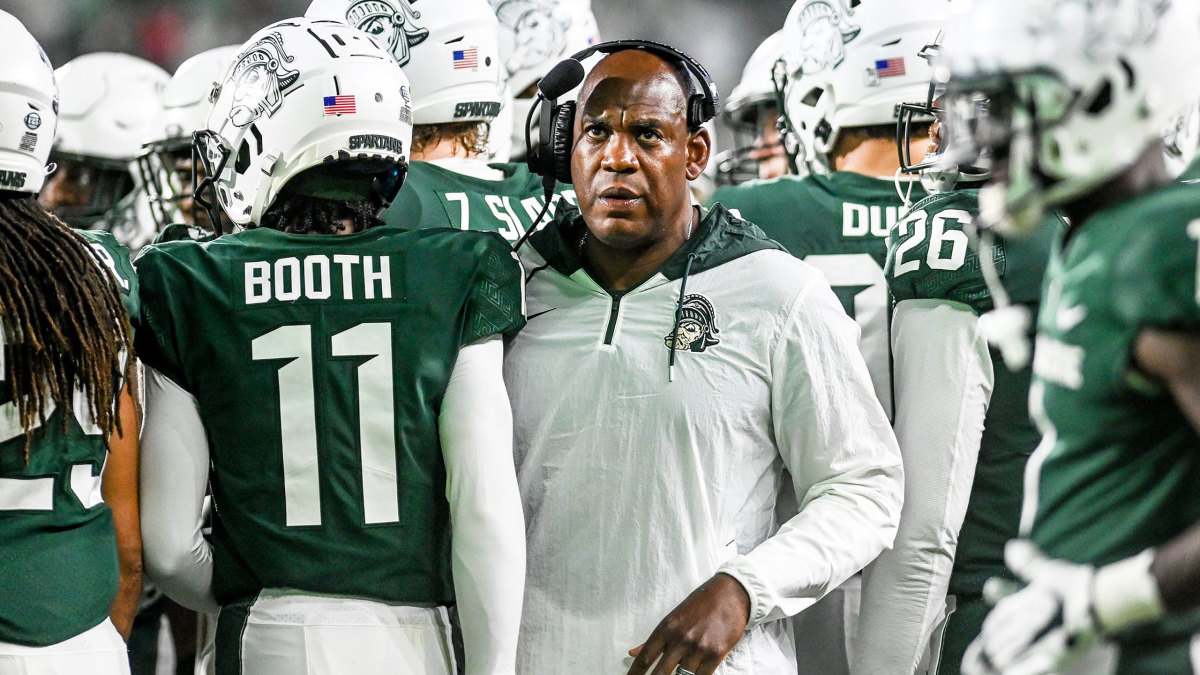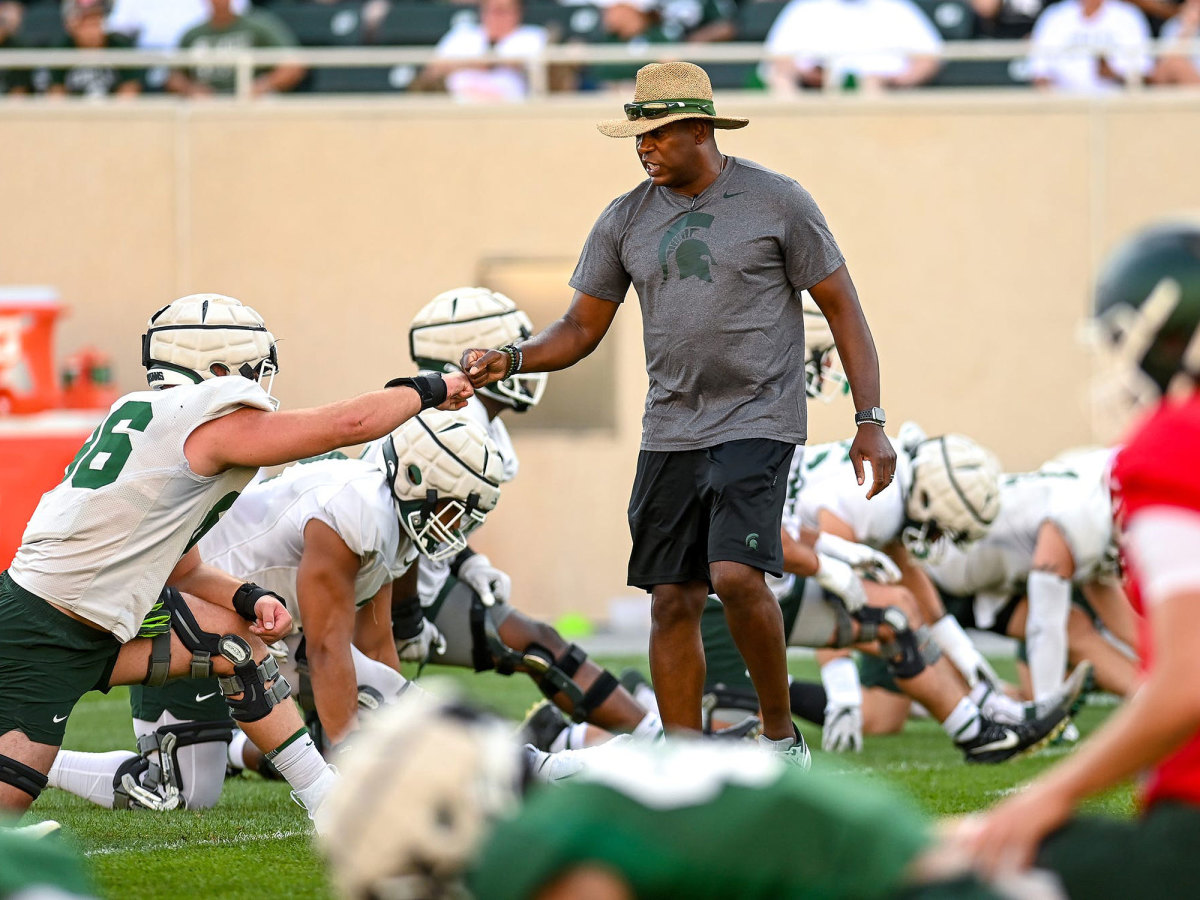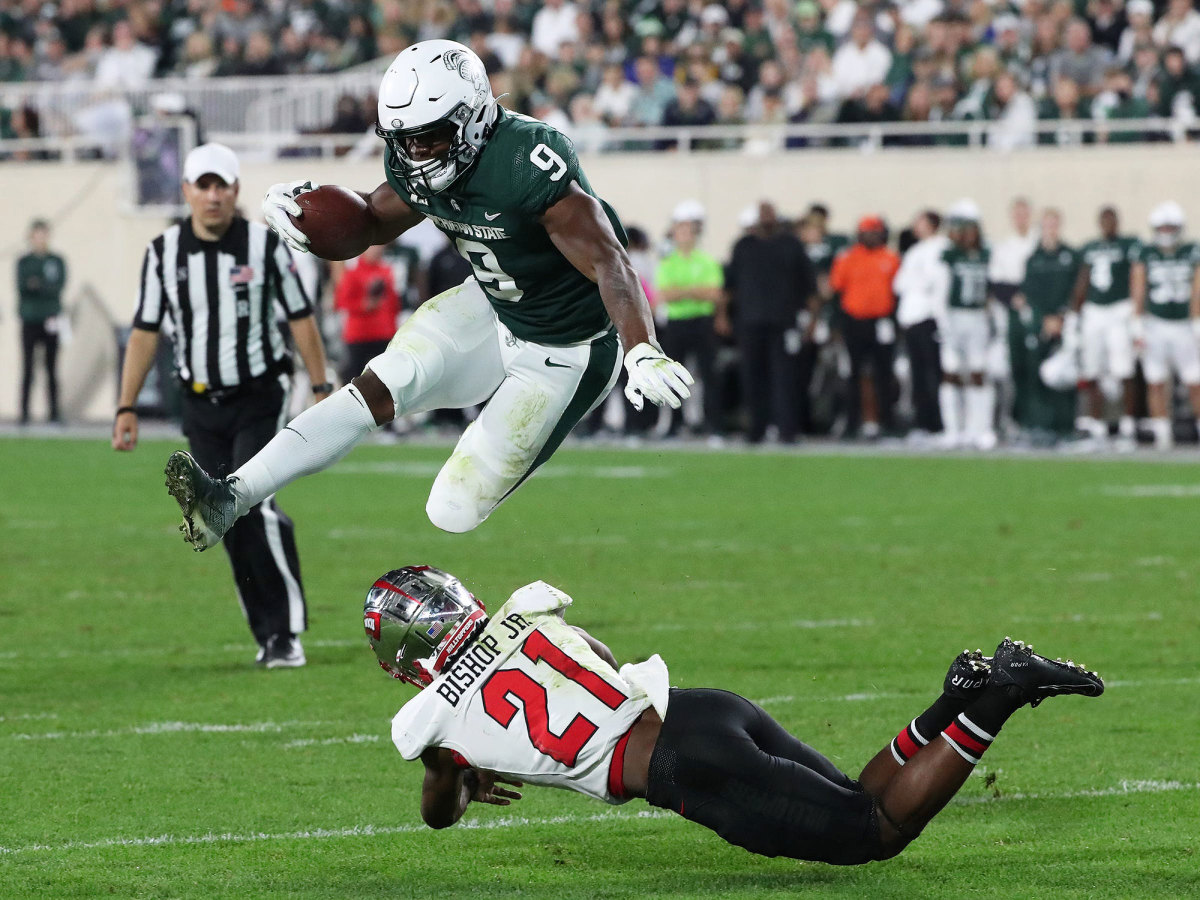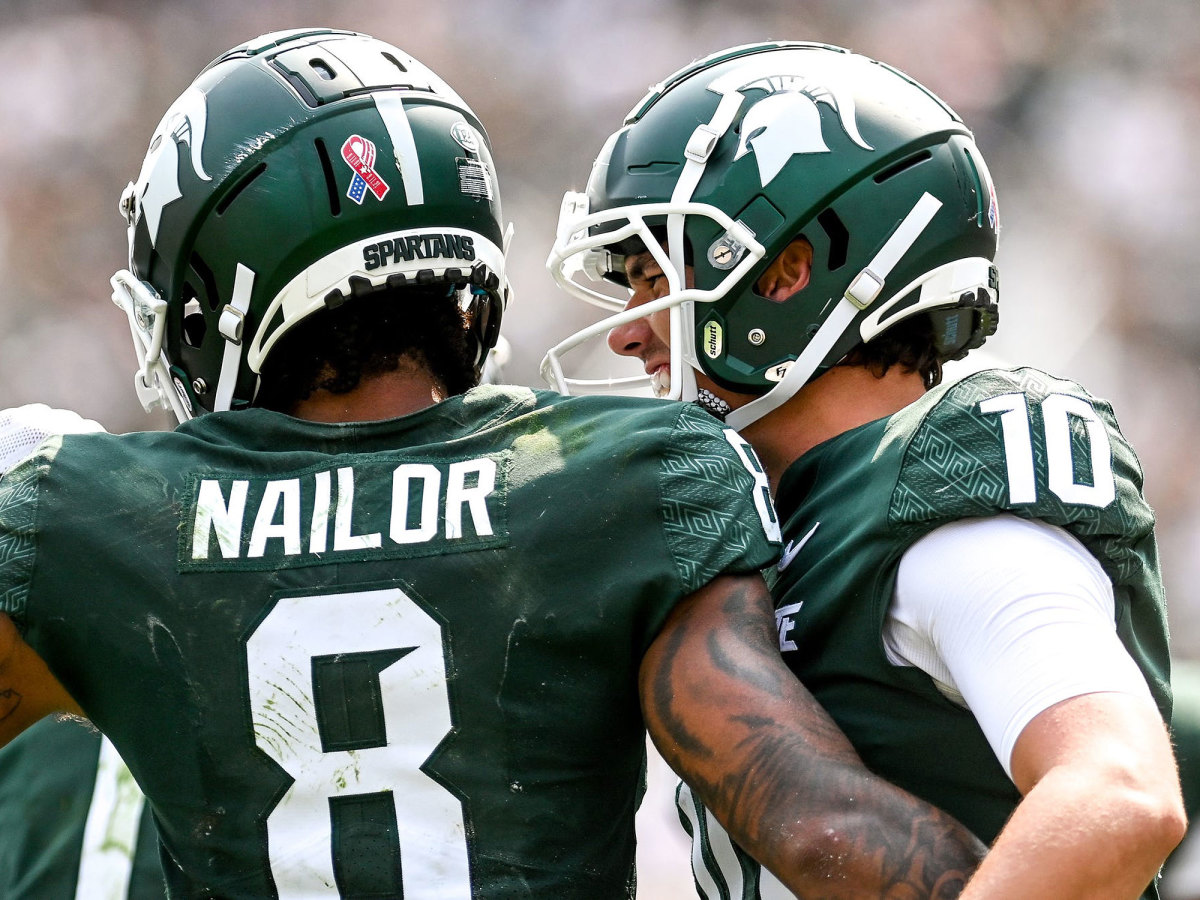Through Talent, Transfers and (Mel) Tucker, Michigan State Has Become the Surprise of the Season

It was unnaturally hot in East Lansing, Mich., Monday, with the thermometer topping out at a muggy 81 degrees. This was after a run of temperatures in the 70s in preceding days, allowing Michigan State students who spend months in layered clothing to maintain their summer attire a little longer while scootering around campus. Everyone knows that the cold is inevitably coming, so they’ll giddily ride this warm wave for now.
That also is the corresponding mood surrounding Spartans football, which has a perfect record nobody saw coming. At 6–0 after a 2–5 COVID-19 mulligan season, Michigan State is the surprise team of college football. The Spartans are good and the Spartans are fun, two things that have rarely happened simultaneously at a program traditionally devoted to the flairless combination of rugged defense and low-octane offense.

Like the weather, this is a hot streak to embrace for as long as it lasts.
Mel Tucker, currently the leading candidate for Big Ten and national Coach of the Year honors, is wary amid the euphoria. At his press conference Monday, Tucker spoke in a voice so soft that at times you had to strain to hear him, measuring his words and largely avoiding the celebratory zeitgeist currently surrounding his program. Tucker has the only Power 5 conference team in the U.S. that has won three road games by 17 or more points, but he’s not here to declare dominance. “We’re still waiting to play a complete game,” he nearly whispers.
That’s how coaches tend to be: preoccupied with the flaws they see on film and in practice; expecting the next opponent (in this case, Indiana) to play its best game of the season; on guard against ruinous effects of self-satisfaction. There is a reason Nick Saban calls external praise “rat poison,” and Tucker coached under Saban at Alabama in 2015 and then Saban protégé Kirby Smart at Georgia from ’16 to ’18. He’s not going to stand at a podium and take that bait.
Tucker was a bit more relaxed after the press conference, allowing himself a few smiles and even some laughter. Inside the locker room at Spartan Stadium, the 49-year-old former defensive back sat on a counter with his legs dangling—not the body language of a guarded man. Wearing gray slacks and a polo shirt, his feet covered in bright green socks and Nike hightops, you could sense the competing characteristics his players often mention: intensity softened by an interpersonal warmth.
He is “having a blast” watching his second Michigan State team take off, validating his 2020 hire at what looked like an inflated price of $5.5 million a year after a single 5–7 season at Colorado. But the grind cannot stop, or even slow down, now.
Two of Tucker’s favorite hobbies, grilling and golfing, have been shelved during the season. Brisket and birdies take time, and there is none to spare now. Even the golf swing simulator he put in his basement has gone unused, though he’s contemplating breaking out the clubs down there “to let off some steam.”
As surprised as the outside world has been by Michigan State, Tucker did sense this breakthrough coming in August. After scoring several coups through the transfer portal and having a relatively normal offseason to build and bond his team, the signs were there in the Spartans’ second scrimmage of preseason camp. “I knew we have enough to get the job done,” Tucker says.
Michigan State’s new athletic director, Alan Haller, remembers something else from a preseason scrimmage. He remembers watching Tucker shake every player’s hand as they came off the field at Spartan Stadium. “He connects with the players individually,” Haller says. “I think they’re really rallying together to play for him and this staff. It’s an interesting culture, and a lot of that starts with Mel.”

Starting with Mel wasn’t the master plan for Michigan State as it entered life after Mark Dantonio in February 2020. After years of great work, Dantonio let the program atrophy around him, stubbornly refusing to part ways with assistant coaches who were no longer performing at a high level. His last two seasons were 7–6 slogs that underscored how offensively obsolete the Spartans had become.
But Dantonio didn’t ride off into the sunset in a timely manner, further harming the program he painstakingly built. He didn’t announce his retirement until Feb. 4, 2020, waiting around to collect a hefty retention bonus and shortening the window for his successor to get started on a rebuilding job. Michigan State went hard after Cincinnati’s Luke Fickell, who has close ties to Dantonio, but five days later Fickell opted to stay with the Bearcats.
Michigan State’s search redirected toward Tucker, who had been a graduate assistant at the school in 1997 and ’98. He had originally rejected MSU’s overtures, even tweeting on Feb. 8 that he was committed to Colorado. From there, Tucker honored a series of previously scheduled CU fundraising commitments and radio appearances—even though Michigan State had come back to him and he was now willing to listen.
It became a messy exit. But Michigan State brass made a huge offer after becoming convinced during a three-hour interview at a Boulder hotel that Tucker was the man for the job.
Haller, then an assistant AD, was joined in that meeting by MSU athletic director Bill Beekman and deputy AD Jennifer Smith. He remembers Tucker arriving with not just a thick binder of plans, but one with pages and file tabs specifically headed “Michigan State.”
“It wasn’t one of those interviews where you could rinse-repeat for another head coaching interview,” Haller says. “It was specific to MSU. He was as prepared as anyone I’ve ever seen in an interview. He had a plan together, a staff he wanted to hire, the salary pool number he needed.
“He said, ‘Alan, I really believe we can win a national championship there at some point.’ He didn’t even talk about a Big Ten championship. I was like, ‘Wow, O.K.’ He helped me dream bigger.”
From there, Tucker embarked on a washout of a debut year. Starting way behind to begin with, COVID-19 shut down everything within a month of his arrival in East Lansing. Taking over a program in transition and without an adequate offseason of preparation, that losing season did at least have two distinct high points: a victory over hated rival Michigan and an upset of 5–0 Northwestern, the eventual Big Ten West champion.
“How he approached last year has helped the success this year,” Haller says. “He didn’t create excuses. He started early [with the] foundation of no excuses.” Foundation laid, the next step was talent acquisition. Michigan State went out and won what has become the instant-impact battleground of college football: the transfer portal.

It took exactly no time at all for Kenneth Walker III to make his presence felt at Michigan State last January. The new running back’s arrival from Wake Forest did not engage in a tentative exploration of sizing up and feeling out his new teammates in winter workouts. He just attacked. “When he walked in the door,” Tucker says, “he just set the tone in the weight room.”
This was business as usual for Walker, who grew up going through workouts with his father in Arlington, Tenn., outside of Memphis. Kenneth Walker II works a warehouse job, and when Kenneth is home from college he switches his hours to the third shift so he can sweat with his son. “He actually does the workout first,” Kenneth III says. “Then I do it.”
This is how Walker, listed at 5' 10", 210 pounds, wound up looking like a young Austin Ekeler. He is a ball of muscle and a bundle of energy, sometimes at risk of working too hard. Monitoring heart trackers, Tucker said the training staff has to actually hold back some of the Spartans during practice, “or they’ll run themselves into the ground.”
Other changes were occurring throughout the program. With staffers devoted solely to scouring portal prospects, the Spartans brought in 15 players via that route at eight different positions. Most of them were from other Power 5 programs and many of them highly ranked prospects coming out of high school. Six have started games this season, including former Tennessee linebacker Quavaris Crouch (fourth on the team in tackles), former Florida and Alabama cornerbacks Chester Kimbrough and Ronald Williams Jr. (the team’s top two corners), and former Arkansas State offensive tackle Jarrett Horst (“just a nasty, nasty player,” says quarterback Payton Thorne).
Tucker arrived with a reputation as a skilled and relentless recruiter, and he put together a staff that can do the job in the talent acquisition area. This was that recruiting mindset in action. “It does matter who you line up with,” Tucker says.
Of that group, Walker is the biggest difference-maker. After sharing the running back position at Wake Forest, he took it over in East Lansing and has become a full-fledged star. His first game in a Michigan State uniform was a 264-yard, four-touchdown rushing effort at Northwestern, establishing himself and the Spartans immediately on the sport’s radar.
Those three big road victories? They’ve also been Walker’s three best games: the 264 against the Wildcats, then 172 at Miami and last week 233 on a career-high 29 carries at Rutgers. He’s the nation’s leading rusher at 152 yards per game, more than 20 ahead of his closest competition. Those numbers, combined with Michigan State’s perfect record, have improbably elevated Walker to the top of a wide-open Heisman Trophy race. “It’s real exciting,” Walker says, with an endearing chuckle. “I believe that’s everyone’s dream. But you’ve got to stay focused.”
All it takes is one loss for Heisman attention to evaporate, which is how this year’s race became so jumbled. But the guy they call “K9,” for his first initial and jersey number, is a Heisman headliner for now.
Walker and his fellow 2021 transfers are not the only reason Michigan State has morphed into an offensive power, though. Some Dantonio era holdovers are becoming stars as well—particularly a pass-and-catch combination that have known each other since adolescence.

Payton Thorne remembers the first time he met the kid they called “Bird.” Thorne was quarterbacking a middle school team outside Chicago when they were informed by the coach that a new player was joining them: Jayden Reed.
The nickname was bestowed on Jayden at a young age by his mom, Kesha, because he would flap his arms when he ran around. But befitting the nickname, Bird could fly on a football field. His speed and Thorne’s arm made for a productive combination.
They hit it off quickly on the field, but even more as life outside football became harder. Reed’s father, Sabian, died in 2015. He’d shielded Jayden from fully knowing the details of his illness, and the news of his passing stunned those outside the family. Thorne remembers learning of it on a Saturday, and Jayden coming to school two days later—somber but intent on carrying on for his late father.
The Thornes are a multigenerational football family, with Payton’s father and grandfather both serving as championship-winning head coaches at Division III North Central in Illinois. They helped support Reed as he navigated life after the loss of his father, as the bond between them deepened.
“He’s family,” Thorne says of Reed.
“He’s a brother,” Reed says of Thorne. “Not like a brother.”
They played together at Naperville (Ill.) Central High School, with Reed graduating a year ahead of Thorne and going to Western Michigan. But when Thorne signed with Michigan State, Reed transferred there. They both redshirted in 2019, working with the scout team. Last year, Tucker put them into action.
Reed started at wide receiver and became Michigan State’s primary kick returner. Thorne got extensive action in three games at QB, but his chance to start in 2021 remained uncertain. It helped his chances when ’20 starter Rocky Lombardi entered the transfer portal (which ran heavily in both directions last offseason, in and out of East Lansing), but hurt when Temple starting QB Anthony Russo arrived via the portal.
A lot of people expected the more experienced Russo to win the job, but Thorne was ready to seize his opportunity. Tucker labeled the competition “extremely close” through preseason camp, but Thorne won out. He hasn’t done a thing to lose his grip on the job ever since.
Pigeonholed to a degree out of high school as a dual-threat QB, Thorne is throwing at a high level. He’s second in the Big Ten and 11th nationally in efficiency at 173.19. His primary target: Reed, whose 21.39 yards per catch leads the conference. But when Rutgers tilted coverage toward Reed last Saturday, Thorne adjusted and hit Jalen Nailor five times for 221 yards and three touchdowns.
Watch NCAA football games online all season long with fuboTV: Start with a 7-day free trial!
In that game, Michigan State became just the fifth team in FBS history to have a 300-yard passer (Thorne), a 200-yard rusher (Walker) and a 200-yard receiver (Nailor). In the two games before that, Reed returned punts for touchdowns. Seemingly out of nowhere, the Spartans have become explosive.
Nothing has underscored the departure from the Dantonio Era more than the sudden onset of big offensive plays at Michigan State. The Spartans have 18 plays of 30 or more yards from scrimmage in six games; the only time in the previous six years that they’ve had more was 19 in 2016—and that was in 12 games.
“You hear people say, ‘This is where they need a long, sustained drive,’ ” Thorne says. “I’m like, ‘No, let’s go score in two plays.’ I love the big plays. When the time is right, I love taking shots.”
This is no longer your father’s buttoned-down, uptight, slog-it-out program. Staid State is dead. Splashy State is making introductions.
Monday morning, Tucker met with his team and showed them graphics that list Walker as a Heisman front-runner. (No Michigan State player has ever won the award.) He also showed them the Spartans’ current No. 10 ranking. Those are great things that should be acknowledged and not avoided, in the head coach’s mind. “There’s no elephant in the room,” Tucker says. “We’re not trying to act like things aren’t happening.”
This, in Thorne’s mind, is part of what makes Tucker an effective leader. “There’s no fake about him,” Thorne says.
But part of keeping it real is informing his players that all the good things happening right now can be yanked away on any given Saturday. That’s why he’s sweating out the trip to Indiana this week. An open date looms invitingly thereafter, and then what could be a massive showdown with Michigan on Oct. 30. Looking ahead, though, is an invitation to disappoint yourselves and all the freshly enthusiastic Michigan State fans.
It is, literally and figuratively, sunny and happy in East Lansing, thanks to Mel Tucker and his talent infusion and the buy-in by the players from the previous regime. Just don’t ask the coach to get too excited, too soon.
More College Football Coverage:
• Best Backup Quarterback Situations
• Week 7 Expert Picks: Will Unbeatens Prevail?
• Evaluating the Best College Football Rivalries
Sports Illustrated may receive compensation for some links to products and services on this website.
